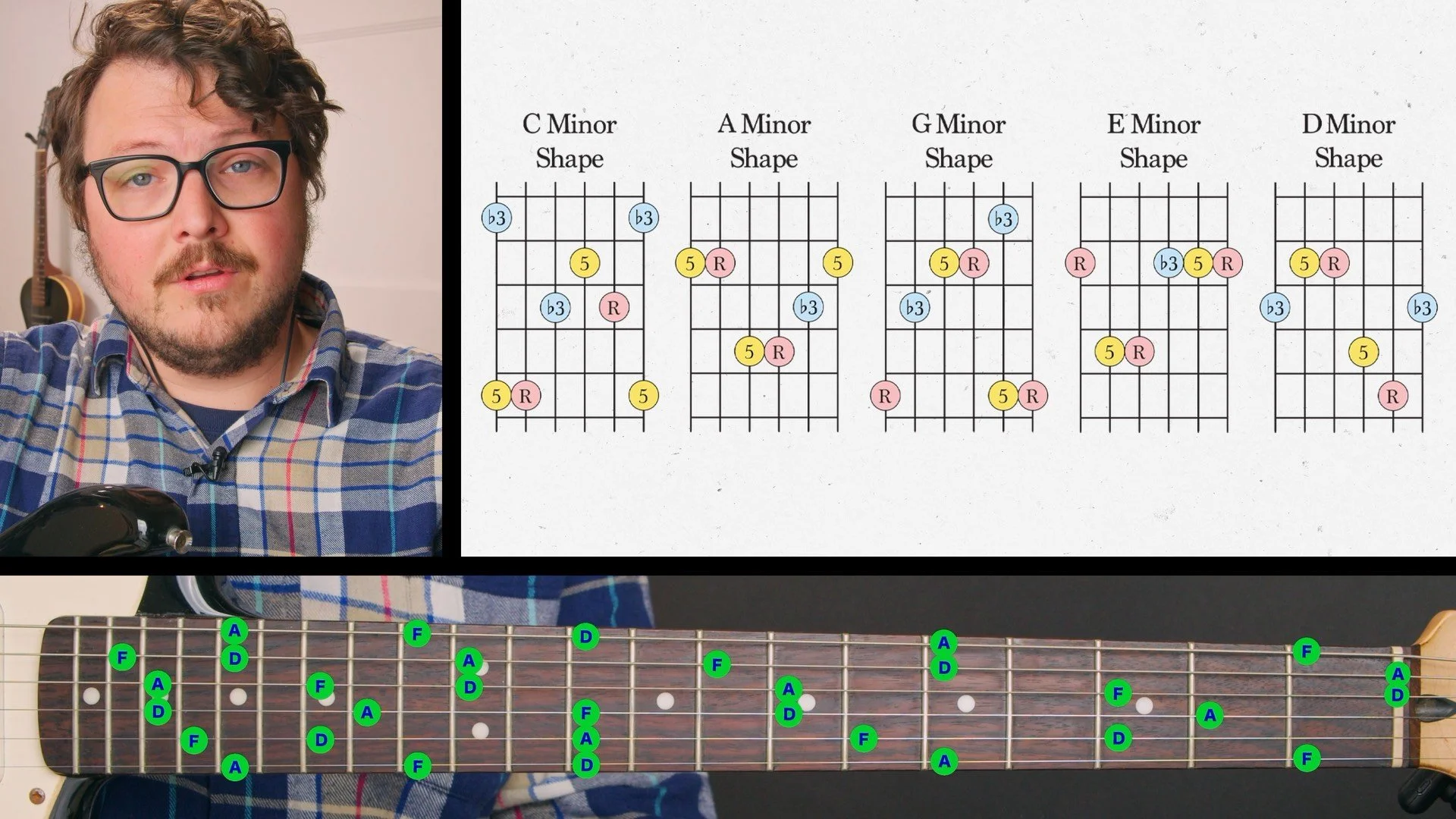


Course Intro:
Lesson 11 | Full Circle
This is it! The final CAGED Basics II lesson!
In this lesson, we start by sliding a pentatonic scale through multiple positions, talking a little about how useful this kind of thing can be for soloing. Then we move into the play-along tune. First, I play through the tune, then I walk you through the variety of shapes and finger choices for each phrase of the tune.
Download the PDF and follow along with the lesson. Use the BPM tracks below to practice the tune. Start slow and work your way up.
Play along tracks:
40BPM
50BPM
60BPM
70BPM (good goal)
80BPM (very nice goal)
90BPM (wow impressive goal)
100BPM (bonus points)
Lesson 10 | Pentatonic Pit Stop
We're in the home stretch with this second-to-last installment of CAGED Basics II.
In this lesson we're exploring the relationship between the D shape and E shape pentatonic scales with a Fix or Foreshadow exercise followed by a practice tune.
Download the PDF (attached below) and use these practice tracks for the tune.
Play along tracks:
75 BPM
85 BPM
95 BPM
104 BPM
Please note: you don't NEED to play the tune perfectly at 104BPM to move on. 85 or 95 BPM is an acceptable goal. It's more about getting the concept and having a clear sense of how you can use these skills in your own writing and practice.
If you'd like to post questions, eureka moments, or your performance of the practice tune, please post to the community forum.
Lesson 09 | D Shape
We're getting close to the end of this series! Get comfortable with the D Shape pentatonic scale and accompanying major and relative minor chords. Watch the lesson, practice the shapes and scale, do the homework, and learn the practice tune at the end! This one is tricky because it's the first pentatonic shape that can't be played in one position.
Lesson 08 | Pentatonic Pit Stop
This is the 8th lesson in my CAGED Basics II series, where I'm systematically working through the relationship between major and minor chord shapes in the CAGED System and how the Pentatonic Scales can overlay on top of this info. In this lesson, we're diving into the relationship between the G Shape and the E shape. You'll start with an exercise to help you think about the Fix or Foreshadow situations involved in switching between these two shapes, and you'll end with a fun tune that spans the G Shape and E shape.
Please note: I played the practice track a little fast because my software required it, but you don't need to play the tune faster than 85BPM to move on to the next lesson, which will be out soon!
Check out the PDF as well!
Lesson 07 | E Shape
In this installment, we'll build the E Shape pentatonic scale from the E Shape triad and its relative minor shape, the D Minor Shape triad. You'll have a little homework (do it! It will help!) and a fun tune to play with E shape and D Minor shape chords to get used to. After this, we have one more CAGED Shape to cover! That means you'll be set up to play anywhere on the neck.
You can find the PDFs and Play-Along videos on the Patreon post.
Lesson 06 | Pentatonic Pitstop
In this lesson, we spend some time moving between the A Shape and G Shape pentatonic scales with a fingering exercise and a tune designed to make you think about your finger choices.
These exercises are designed to give you a manageable playground to practice what many beginning & intermediate guitar players would consider the most under-explained aspect of guitar playing: choosing which fingers to use and why.
I learned things like this while taking classical guitar lessons, but even then I had to infer the logic from the written fingering. This "fix or foreshadow" idea isn't an all-encompassing method, but it is a great start for designing your own ergonomic path through a melody, riff, solo, etc.
Play-Long Tracks available on Patreon Post.
Lesson 05 | G Shape
In this lesson, I'm continuing to use the CAGED framework of triads to flesh out more information on the fingerboard, this time with the G Shape.
Like the previous lessons, we've got a lesson section, homework section, and practice section.
Get comfortable with these concepts, enjoy practicing the tune, and move on to the next lesson, where you'll get to practice playing a tune that slides around all three pentatonic scales we've covered so far.
The PDFs are attached below.
Post your questions, eureka moments, frustrations, practice track progress, etc related to this lesson on the community forum.
Lesson 04 | Pentatonic Pit Stop
Hi Everyone,
Instead of introducing another pentatonic shape, this lesson breaks down a variety of ways to practice moving between the two pentatonic scales we've covered so far. There are more options than I've laid out in this exercise, but I think this gives a great start for those of you looking to mesh scale shapes together in a seamless way.
And of course, you don't always HAVE to slide between shapes, but sliding makes it a little more fun and helps connect the scales in a tangible way.
You can just google the word "metronome" and you'll find a variety of options.
Post your questions, elations, frustrations etc below or on the community forum.
Lesson 03 | A Shape
Check the chapter markers on the video above for the Lesson, Homework, and Practice sections and download the PDFs at the bottom of this post.
In this video, I break down the A Shape, it's relative minor shape (the G minor shape), and how the A Shape Pentatonic scale overlays on top. There is a huge difference between knowing your pentatonic scales vs seeing how they interact with the CAGED System. As this lesson continues, I hope you start to appreciate how the CAGED System helps music theory come to life on the guitar neck.
Lesson 02 | C Shape
Welcome to Lesson 2 of CAGED Basics II. Please watch Lesson 1 first.
In this lesson, I'll help you get much more familiar with the relationship between the C shape triad, the A Minor shape triad, and the C shape pentatonic scale. Check out the PDF attached at the bottom of this post.
Each episode of this series has a Lesson section, a Homework section, and a Practice section. My goal with this format is to first get you familiar with the concept in the Lesson section, then let you get to know the concept for yourself in the Homework section, then finally give you something to play that uses the concept in the Practice section. You can find bookmarks embedded in the video above for each section.
Lesson 01 | Minor Chords Overview
Before starting on this CAGED Basics II series, please make sure you're comfortable with the concepts in Music Theory for Guitar and CAGED Basics.
CAGED Basics II is all about how to integrate minor chords and scales into the CAGED System. My goal with this series to to help you understand the logic and usefulness of layering this kind of information on top of the basic CAGED shapes you're already familiar with. This first lesson is an overview and introduction, so the concepts are broad. The following lessons will go into much more detail.
The video above has chapter markers labeled "Lesson," "Homework," and "Practice." Below, I've attached a PDF for each section as well.
The Lesson section helps you understand what I'm talking about, the Homework section helps you get to know the concepts for yourself, and the Practice section helps you apply the concepts to guitar with a fun practice track.
Check the Patreon post description for links to the BPM Practice Tracks.
This course is ongoing. More lessons coming SOON!











